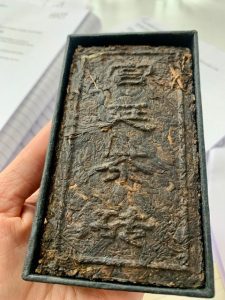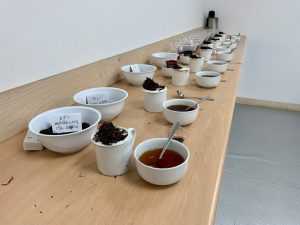SIX TEA TYPES
Anete just had the opportunity to go to the UK Tea Academy, thanks to Canton Tea, our tea partners, to do the Level 1 Tea Champion course. Two days of intensive tea training, and we are absolutely stunned. The tea world is so rich, so full of culture and flavour!
What I learned that I can share with you now? Quite a lot about tea history, culture, different sensory characteristics of different teas from different terroirs and cultivars, but mostly about the six different tea types. So what are they really? It is what you now know as – green tea, black tea etc – they all come from the same species tea plant Camellia sinensis, but they have been processed in a different way to get different results.
• White tea – the least processed of all, usually the bud or the bud and first leaves are picked very carefully. That is left to wither to reduce moisture as much as possible and then dried. Some imagine that this will have less caffeine than other teas, but the buds are usually the most concentrated since they have to be most protected from pests, so it’s just a bio response as pesticide synthesised by the plant.
• Green tea – made without any oxidation, the leaves are withered just slightly and then pan fired, heated in a hot wok in China, for example, or steamed, mostly in Japan, so this denatures the enzymes and oxidation doesn’t take place anymore. Think of what happens when you blanch some broccoli, you throw it in some hot water for a short time, take it out and it will stay nice and bright green. Then the tea leaves are rolled and shaped and then fully dried.
• Yellow tea – I had never tried this before, but it’s quite interesting. The tea is withered, pan fired, and then covered in some cloths while it’s still hot, so a non enzymatic browning happens, something like a slight caramelisation, the pan firing is done again and it is wrapped in the cloths again, this is repeated for several times, and then dried fully in the end.
• Oolong – It is an oxidative processing method, so it can be anything between 20% up to 90% of oxidation. It is made differently in different areas, but the leaves are normally bruised for some time for them to get to the desired oxidation level. Oolong in, Chinese Wu Long, actually means Black Dragon, because in the shaping some leaves will get a dragon-like appearance. There is also a different type – the jade oolongs – jade because of their brighter green color, and they are mostly balled leaves. This is a very rich category, because there is such a big range of oxidation they can have, so such a big flavour variety too!
• Black tea – so black tea, you guessed it, is 100% oxidised, the tea is either made in the orthodox (traditional method) where the leaves are rolled for a long time either by hand or in special machines and is then left to oxidise completely before drying, or it can be made in a faster more industrial way called CTC – that is basically what you usually find in lower grade paper tea bags, as it is “crush, tear, curl”.
• Dark teas – last but not least, the fermented tea category. Remember that other teas are not fermented because microorganisms aren’t important and don’t participate in their production. In this category however, they play a fundamental role. The most known one is probably Shen Puerh (Raw Puerh) and Shu Puerh (Cooked Puerh). Raw Puerh is very fascinating because the tea is withered and rolled, dried under then sun and then steamed slightly to press them into tea cakes that will later on ferment for various years. There are some teas even 20, 30 or 50 years old! So you can imagine it is a pretty complex and expensive way of making tea for tall the time you have to wait for the flavours to develop! Cooked Puerh is a faster method that was invented not too long ago to “speed up” the fermentation process – the first steps are the same as in Raw Puerh, but instead of steaming slightly and pressing it into cakes to ferment for many years, the tea will be sprayed with water and left to ferment under cloths for a month or so. It will be dried and either left loose or also pressed into cakes, but this tea will not continue to mature as it will have already fermented before! A faster and cheaper version, as you can imagine.












